Most entrepreneurs start off being empowered by one of two very good reasons; sometimes both: A passion for what they (are about to) do, and the urge for the profits they foresee being generated by the new venture. That being said, we mostly see brands talk about the passion that drives the founders and employees. It’s hard not to catch any brand doing it; from most massive food brands such as Chipotle to the few true passion brands like TOMS.
At times you come across a very honest, true-to-yourself, reason that goes beyond your passion or drive for financial success. It is so simple, it’s scary. And when done right, it is so radical that most steer away from it out of fear to upset and turn away potential customers. Herein lies the genius of a founder personality. Not brand personality, but a founder’s personality being infused so heavily into the venture that the brand becomes the person and (s)he calls shots in the public that most CMO’s would get fired for.
An amazing example I came across recently, while spending quality time with my folks in Austria, is that of shoe-maker GEA. The company produces in-house (on-site), hand-made, long lasting and easy-to-repair traditional Austrian footwear. GEA’s social and environmental record is beyond outstanding. So far so great, but now add the underlying layer of true founder personality: The shoe company publishes a political newspaper called Brennstoff (translated: ‘fuel’), in which the owner, Heini Staudinger (a great wiki read for those of you who can read german) boldly voices his opinion and pushes the envelope on a very clear and steady social course; one that many don’t appreciate, one that upsets corporations, investors, banks and the government, and one that the ones who do appreciate, truly love.
And that’s what makes a true founder personality: unafraid to exclude the many, extremely powerful to the few.
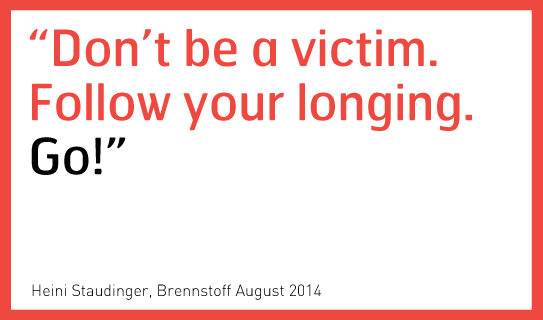
The for-profit company, which is named after the goddess of earth, condemns consumerism and capitalism (even releasing their own currency called ‘Waldviertler,’ which is accepted by 200 regional businesses) and yet attracts so much investment money (through crowdfunding) that they are looking past their 41 stores to unconventional ways of expanding their operations, such as founding an academy. Heini Staudinger’s GEA is living proof that going against the grain and staying true to your personal beliefs, even if they are based on extreme political opinions (or religious beliefs), can be a powerful branding tool that deserves consideration when crafting your new brand’s personality. It may turn out to be your own, undiluted and uncensored, personality that will turn into your brand personality. How about that for ‘radical’ brand thinking? Don’t think at all, just ‘follow your longing and go!’
Don’t hire us to create your logo. Not us, nor anyone else therefor. Sure, we could create a great logo for you. It would look timeless, be very well designed (I believe we are one of the best, and many agree), it would work across platforms and for years to come, and everybody would be telling you how much they love it. So why shouldn’t you hire us to create this important piece of branding for you?
Chances are you don’t need a logo designed. Not yet.
Chances are you need a brand built, and your logo is just a part of it. By creating a logo in a vacuum, and out of sync, you will likely fail. I don’t want you to fail. Nor be part of failure. I think we share this belief as entrepreneurs.
It’s the cart before the horse idiom: Why put the horse in place if we don’t know the message by the messenger yet?
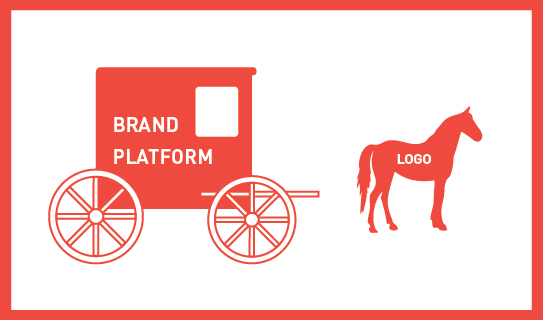
Below are 4 key elements you have to have in place prior to embarking on your logo design; they are the bare minimum requirements, the wheels of your cart so to speak:
1. You have a positioning statement in place that focuses on the ‘why’ and you stand tall behind it
2. You created 3 target audience personas that stand for who you are actually talking to/with
3. You know your brand personality and its associated keywords and are ready to act upon it
4. You have created a meaningful name that responds successfully to all of the above
If you don’t have these in place, creating a logo would be wasting your money, and (y)our time. It’s a lose-lose situation. How would any designer know what to design without these in place; how would the logo convey what it needed to convey; and finally, how could it connect with your audience? I don’t know, but I see it happen every day on the client’s expense.
Contact us if you need help getting there, as we love to assist and contribute, while speeding up that journey to your brand image.
CATEGORIES: Blog Your Brand Launch: Brand Strategy Your Brand Launch: Identity Your Brand Launch: Naming
A startup is vulnerable; very vulnerable.
They will notice.
They will steal and copy.
They will undercut your price.
They will be bigger and more powerful than you.
Welcome to entrepreneurship!
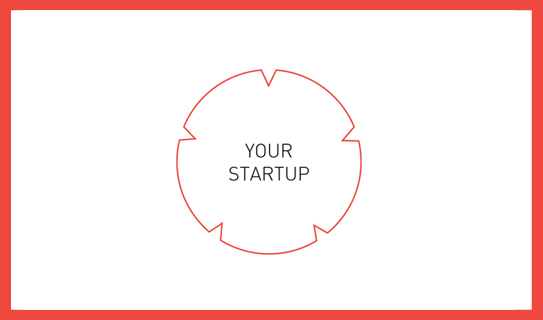
Your startup has many weak areas that require protection
Despite the idea of branding being about positioning, image and voice, for new ventures branding provides something of much greater value: A thick layer of protection.
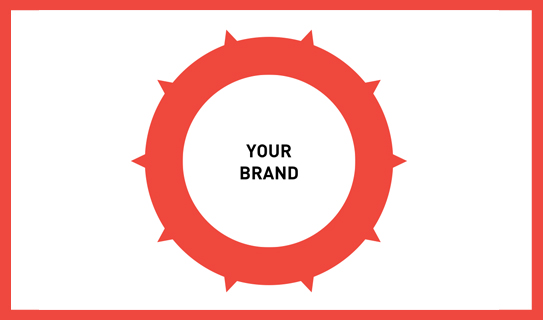
Launching your new venture as a brand provides a thick layer of protection
With a startup product or service you may be so intrigued by its novelty or functionality that you decide to make a purchase.
With a brand you fall in love, and love is a strong word. Love does not fade easily. Once you created love, you will compete on a much higher level, one that is not about price. Your initial customers – the ones you have to fight so hard for to gain in the initial months upon launch – will quickly abandon ship for a cheaper variation, or a competitor’s added feature, if you did not make a conscious decision to invest (time and money) into the process of translating your startup into a brand at time of launch.
Branding for new ventures is first and foremost about an emotional connection, a strong immediate bond, between product/service and person (the customer). If you make that happen, you can sit back and let the competitors come your way; you are protected.
Let me know if you have questions about turning your startup into a brand, or if we can assist hands-on. You can also use our rather vast library of resources. However you go about it, start creating that layer of protection around your new venture; you will thank me later.
Do you remember this song? Talk Talk by the highly influential 80’s band Talk Talk?
That’s right, you do. It was rather memorable. Lucky for them, as they named their first song on their first album (their second single release) after their newly formed band.
That takes real guts.
And guts can result in glory…or defeat. Brutal defeat that is. A risk that many new ventures are willing to take when they name their product the same as their company, or vice versa. It is a move that most often is based on a swift launch. Rarely is the decision to name an offering and its company alike a choice of strategic nature.
When Talk Talk decided to choose Talk Talk for their ‘inaugural song’, there was a risk involved in case the song sucked, but the band had a decent amount of control over that. The song did not suck, instead it defined a sound that they built their entire career on. You hear Talk Talk (Company Name) and you automatically hear the song Talk Talk (Product Name) in your ears. Smart move.
In the entrepreneurial world though, betting on your one product to turn into a hit is a gamble that only gets amplified once you decide to diversify your portfolio of offerings down the road. Levi’s had a major hit with their jeans, then they tried selling khakis and failed doing so under their brand name; they had to create Dockers.
Here’s to you, Talk Talk, for tempting entrepreneurs to take this risk. For the ones that aspire to lead through brand strategy though, you may peruse our white paper on brand architecture instead (while listening to any 80’s hit of your choosing).
Oh yes, the good old Positioning Statement; used for decades, it still is the single most powerful tool to define a new venture’s audience, category, benefits…and reason for believing. Powerful, because this is all part of one single sentence; a sentence that many Founders struggle with, as a recent poll of ours showed.
When I work with clients on defining, and refining their positioning statement as part of our Resonaid™ workshops, it takes between one and four hours to get this sentence right. Yes, power comes with responsibility, and questioning the reason for being, and for believing in any new venture is worth a few hours of pondering.
Search for the term Positioning Statement and you will be surprised by just how varied the approaches to a classic branding tool are. It is most astonishing that a majority of statements leave out the most essential part of it; the reason to believe.
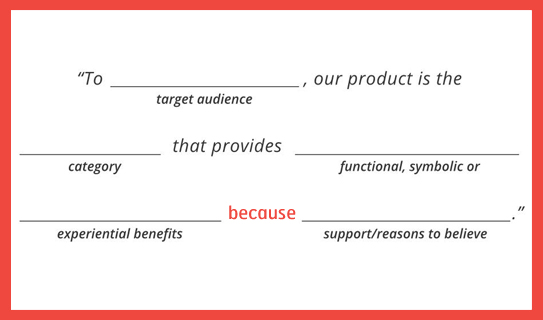
Most statements focus on the differentiators, ours (pictured above) focuses on the ‘because’ – the part that takes time to ponder and to perfect. It is also the part that will truly differentiate your venture from others. It puts your venture to the test: Is it truly a big idea? Is it important? Can it be bigger? Should it become more important? Is this why I will work late nights and put a lot at stake?
The big question ‘Why’ has been making its rounds past the branding community for a while now, most noteworthy through Simon Sinek’s TED talk. Despite its popularity, just like is the case with the mundane idea of writing a positioning statement altogether, the ‘because’, the key part that will indeed generate you sales, is often neglected. If you found an excuse not to tackle this sentence for your venture, take these words as a gentle kick in your behind and make today the day for accomplishing it. It will change your venture for the better, guaranteed.
Be a Waiter? Waiter…as in the service personnel in a restaurant?
That is exactly right. Your B2C or B2B brand should aspire to turn into the best waiter you can possibly imagine. When I spoke at Innovate Pasadena a few weeks ago, I found myself making this statement out of the blue at the beginning of my speech, and I felt it was an analogy worth sharing.
I am certain you had those moments when you were on a romantic date, an important business lunch, or in midst of a highly stimulating conversation with an inspiring person when the waiter interrupted to tell you about today’s specials. Here you are, having gone through many steps to arrive at a magic moment, just for the waiter to kill it in an instance. Of course the service industry as a whole is a great place to zoom in on when it comes to ways of ruining (or magnifying) a great experience, but the intimacy of a restaurant setting can amplify the bad moments.
Let’s focus on your favorite restaurant with your favorite waiter instead:

He does not interrupt, instead he knows exactly when, and how, to check on your wellbeing. It goes far beyond food orders, refills of water, pouring of wine, or asking if the food is to your liking. It is about careful observation and impeccable intuition. A great waiter knows when to appear and when to disappear, when to speak and what to say, when to assist and in what matters, and when to silently observe.…and all of this at just the right moment. A great waiter fits into the experience like a puzzle piece, when – and only when – you want, or need him. That’s what your new brand should aspire to: Equipped with a deep understanding of your target audience, your brand acts like a mindreader.
Impossible? Think of that special restaurant with that special waiter. It is happening in restaurants around the world; but only the few that put the extra effort into it – and it is mighty memorable for their customers. Aspire for your brand to put in that extra effort to turn into that amazing waiter. Your audience will remember, share and repeat their experience, regardless of the price tag.
How to outlast Trends?
Turn a Want into a Need. A Need is usually not temporary, a Want often is.

If as an entrepreneur you uncover a trend to tap into, it can be done in a short-term, unsustainable, yet highly profitable manner: Start shop quickly, gain momentum fast, maximize sales and dissolve immediately upon peak. Done deal. You did not build a brand, but sold a trendy product or service that has run its course, but in a profitable manner.
If you are in it for the long term, despite leading with a trendy product or service, and you want to build an actual brand, ensure to have a long term brand strategy formulated. It does not even need to have a direct relation to the trend, only to the audience and category. Your audience would not know, they are blinded by (and excited to buy into) the trend, but once the trend fades, the audience is yours and you will be ready to tap into them with the next product or service that speaks not to their initial Wants, but this time to their Needs. You planned for that to happen. The consumer already likes your offering, and if the trend faded, but you have another product ready to sell that fits their needs, they will make the purchase based on the trust your brand has established. You successfully created a trendy product and turned it into a sustainable brand. With this strategy you tap into a momentary want (a trend) yet allowing you to keep the same consumer for their ongoing needs.
If you are destined to dive into the risky business of building a brand based on a single trend, make sure to lead with the candy row for their wants, but then build the rest of the store to sell them the meat and potatoes they actually need.
Imagine you own a well established, sophisticated Mexican restaurant in a wealthy neighborhood that is frequented by out-of-towners as much as by locals and has been receiving rave reviews for years. You made a good living and decide to buy the Irish pub a few doors down the street, on the same block.
So far so good.
Your logical next move is to announce to your customers that you now run another great establishment, serving different cuisine and drinks, same quality, same owner, just a few doors down. Have a pint after your dinner!
And this is where a perfectly logical move is costing you customers instead of gaining them, because you thought of your customers instead of like them.
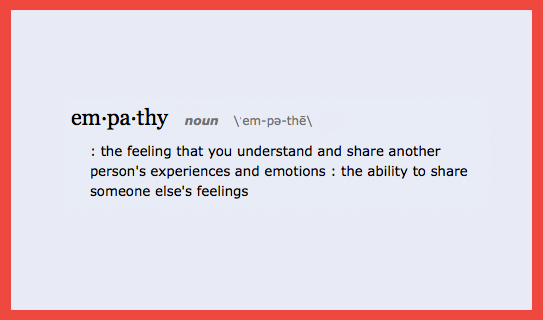
This is not a fictional story. I was reminded of that anecdote when I talked with a client last week about how he must hone in on his target audience and focus on a singular message that speaks to his specific offerings and their specific needs. Sounds so simple, but as you can see, it is not. The temptation to reach out to your customers, or to widen your offering or your clientele, often leaves the most important part of branding left behind: Empathy.
Don’t think of your customer, think like them. If you would, you would never dilute your established authentic Mexican restaurant brand (which is about an authentic and cultural food experience) with Irish pub chatter (which is about pints in quantity rather than quality). While dining at said restaurant, I saw a tabletop advertising their ‘other’ completely unrelated venture and it turned me off in an instant. So much so that I started coming in only once every month instead of once a week. If the owner would have thought about why people loved her restaurant, she would have ensured to separate the two businesses (A Brand Architecture exercise would have made that crystal clear), their respective audience and outreach.
This particular venture experienced organic growth, and that often leads to brand disasters. Thinking like your customer is the single most important thing you can do as an entrepreneur while establishing your brand, and the one that entrepreneurs tend to be doing the least. Next time you communicate on behalf of your brand, ask yourself: Is the whole enchilada worth the pint?